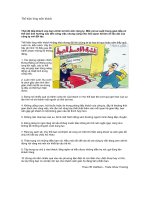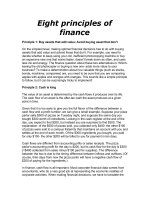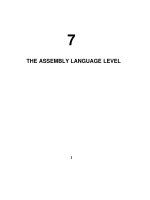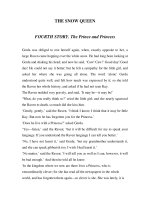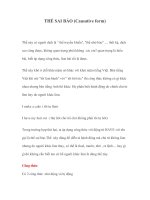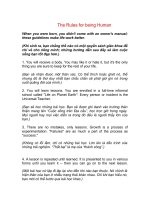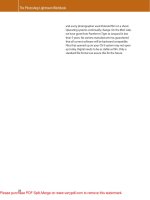Tài liệu The Art of Community - Building the New Age of Participation pdf
Bạn đang xem bản rút gọn của tài liệu. Xem và tải ngay bản đầy đủ của tài liệu tại đây (19.93 MB, 574 trang )
Praise for The Art of Community, Second Edition
“In recent years, the growth of community management has been noted
across a range of industries, and there is no better mentor than Jono Bacon
and The Art of Community for unraveling this new profession. Jono provides a
comprehensive guide to growing and empowering communities and taking the
time to cover the many subtleties hidden in the details. Highly recommended.”
—AAron Fulkerson, Ceo, MindTouCh
“One hundred years ago, there was no such thing as a “product manager” or
a discipline of “product management.” In The Art of Community, Jono Bacon
takes the best and boldest step toward showing the emergence of another
new discipline in business: community management. This is a non-optional,
pragmatic business function that every executive needs to understand and
invest in right now.”
—sAM rAMji, VP oF sTrATegy, APigee; PresidenT oF The BoArd, ouTerCurVe
FoundATion
“It was a privilege and honor to be asked to provide a testimonial for the second
edition of The Art of Community, although at first I was a little bemused, as I
wondered what he would add to something he’d already covered so well with
such insight. Well, after reading the second edition, I certainly see it was time
well spent on his part, and even more so for the reader. As someone who has
been consulting in open source for almost 15 years, I’ve seen a lot of what
works and what doesn’t, as well as lots of trial and especially error. Reading The
Art of Community WILL make you smarter and at the same time more caring
and considerate of your community colleagues and allow you to reduce the
number of trials you go through. At the end of the day, we can’t all be Jono
Bacon, for whom much of this seems effortless, but through a carefully blended
combination of theory, practical advice, and illustrative stories, he’s managed to
provide us with a path to ultimate community nirvana.”
—Andrew AiTken, Founder, olliAnCe grouP, A BlACk duCk soFTwAre CoM-
PAny, And The oPen sourCe Think TAnk
Praise for the First Edition
“The Internet provides the potential to separate us into a cacophony of
discordant voices or to congregate us as purpose-driven communities. Jono
Bacon, in his insightful The Art of Community, teaches the latter path, detailing
the principles of successful community-building in a way that will appeal
to both neophyte and expert alike. Given the increasingly critical role of
community managers in the technology industry and beyond, The Art of
Community should find a place on any businessperson’s bookshelf, not to
mention that of the PTA president, book club organizer, or union activist.
Yes, it’s that good.”
—MATT AsAy, AlFresCo And C|neT
“Jono Bacon truly understands communities, and, more importantly, how to
build communities that thrive. This is the definitive guidebook to building
successful communities—definitive because it is based on Jono’s extensive
experience as community manager for Ubuntu, a product that inspires an
Apple-esque devotion in very large part because of its vast and dedicated
community. For developers and entrepreneurs who want to learn how to tap
into the power of community, as Ubuntu has done so masterfully, this book is a
must-read.”
—iAnMurdoCk, Founder oF deBiAn And ViCe PresidenT oF eMerging
PlATForMs AT sun
“One thing that’s impressed me about Jono Bacon—something one can notice
back when he and others were building a community around their pioneering
Linux podcast—is that he simply gets the concept of community. It comes out
in most everything he says and most every decision he makes. This is the kind
of a person you want writing a book on the topic. Open source community
building cannot be boiled down to a formula. It’s a constant effort, a soft
science, an art, and Bacon is an ideal art teacher.”
—dAn goldsTein, ProFessor oF MArkeTing, london Business sChool, And
PrinCiPAl reseArCh sCienTisT, yAhoo! reseArCh
“The success of the open source software movement demonstrates that no
obstacle is insurmountable when people come together around a shared
vision. In The Art of Community, Ubuntu Community Manager Jono Bacon gives
readers a profound glimpse into his hands-on experience as the orchestrator of
one of the movement’s most powerful communities. His book offers valuable
lessons on effective leadership and community building. Its compelling
combination of useful theory, real-world best practices, and instructive
personal anecdotes make it a richly comprehensive guide for both aspiring and
experienced community leaders.”
—ryAn PAul, Ars TeChniCA
“Communities are very complex ecosystems of human beings. Cultivating,
growing, shaping, and guiding the community to make it productive is
definitely as much (or even more) art as science. In The Art of Community, Bacon
does an excellent job of explaining in detail the considerations for managing
and cultivating a healthy open source community. He provides a blueprint for
developing and maintaining an open source community in a programmatic
way, and his attention to detail and understanding of the dynamics of
communities make this book an invaluable resource for anyone looking to
build and maintain a community. Drawing from his own extensive experience,
Bacon does a great job of explaining how to help foster a community, and
provides great advice, ranging from choosing infrastructure, measuring
growth, and even hiring a community manager. All in all a must-read for any
community manager.”
—MArk r. hinkle, ViCe PresidenT oF CoMMuniTy, Zenoss, inC.
“Jono Bacon has long been an insightful voice for the open source community.
Now his artful stories distilling the ethos of organizing people and activities
on the Net, at conferences, and in our daily routines provide a framework for
successful, community-building strategies.”
—PeTe kronowiTT, linuX And oPen sourCe sTrATegisT, inTel
“In The Art of Community, Jono Bacon once again shows that his nom de guerre
is apropos. He breaks down the soft science of community management in a
way few others could. With his trademark British humor, he deftly explores
the intricacies and subtleties of his trade. The result is both informative and
entertaining, and is a must-read for those looking to better understand the soft
science that is community management.”
—jereMy gArCiA, Founder oF linuXQuesTions.org
“To a soundtrack of heavy metal, free-software geekstar Jono Bacon recounts
the story of how he learned to gently yet productively manhandle groups
of unruly Internet folks gathered around a common topic or cause. His
process and methods are set out in his book, The Art of Community, where
Jono’s non-ego-driven account of community building will aid all manner of
bosses, since almost every subject matter these days has a community with
hundreds, thousands, tens of thousands, and even (as in the case of World of
Warcraft) millions of people clamoring around it. (Even David Hasselhoff!) Be
forewarned, capitalist! There is no chapter called ‘How to Turn Communities
into Dollars,’ but following Jono’s suggestions may yield you what every
leader (even a capitalist) wants: a loyal and passionate community willing to
collaborate to achieve a common goal.”
—irinA sluTsky, geekenTerTAinMenT.TV
“If you listen to open source fans, you might get the idea that the community is
elves who come out of the woodwork to fix your broken software while you
sleep. In The Art of Community, Jono Bacon explains how reality is a little more
complicated, and what the community needs in return. This book will help you
get started with the diverse skills required to keep a collaborative community
on track, including copywriting, social software selection, conflict resolution,
and measuring if it’s all working.”
—donMArTi, ConFerenCe ChAir, oPensourCeworld, And orgAniZer,
windows reFund dAy, Burn All giFs dAy, Free dMiTry, And FreedoMheC
“Who would have known, when I first met a scruffy student from
Wolverhampton Uni at a LUG meeting all those years ago, that he would end
up being the name on the Internet synonymous with the word ‘community.’
The fact that the Internet’s Jono Bacon is now one of the foremost authorities
on building and nurturing a community shows that in a volunteer project no
one cares about your questionable dress sense, dodgy taste in music, or strange
choices in facial hair—all that matters are your contributions, and your ability
to get on with, and inspire, others.
“In this book, Jono draws upon a wealth of experience from projects small to big
(and when you consider the worldwide phenomenon that was LugRadio, and
the worldwide phenomenon that is Ubuntu, you’re talking pretty big) to lay
out a blueprint for creating and sustaining communities, as well as using real-
world examples from prime ministers to celebrity chefs to ground the topics in
a wider context. There is a nice balance in that many of the examples are based
on success stories, but Jono is brave enough to also illustrate his points with
some of his (relatively few) mistakes.
“This book will be useful for anyone looking to build a volunteer community
around any kind of project or cause, whether it involves software, open source,
raccoons, or none of the above.”
—PAul CooPer, MoBlinui & APPs engineering MAnAger, inTel
“As a rock-solid book, The Art of Community is not only about communities,
but also management, organization, and even marketing—it is the bible for
community leadership. This book should have been out a long time ago, and
reading through the chapters made me reflect on almost every important
situation I had to face with teams, from conflicts all the way to handling buzz.
It would have helped solve some of the issues I was stuck in much faster than I
did (although all the issues solved in the end were exactly how Jono described
it). I am eager to apply more of this wisdom on the current projects I am
involved in.”
—seiF loTFy, gnoMe FoundATion, ZeiTgeisT CoFounder And TeAM leAder
“Few people, in my experience, understand how to create, build, and support
community better than Jono Bacon. With The Art of Community, Jono’s
taken his experience, his intelligence, as well as his great humor, and has
effectively distilled it into an indispensable book for anyone who wants to
start a community (whether around software or any other shared interest or
endeavor, really) or participate in one in a positive and productive way. Jono
understands that communication and authenticity are at the core of effective
participation, and goes beyond the theoretical to provide practical guidance on
things like governance, process, conflict resolution, and avoiding burnout that
is right on the mark. The Art of Community is an excellent book!”
—dAVid sChlesinger, direCTor, oPen sourCe TeChnologies, ACCess Co., lTd.;
gnoMe FoundATion AdVisory BoArd MeMBer
“Jono Bacon, in The Art of Community, takes you on a personal journey to the
heart of what it takes to have and become part of a productive and well-oiled
community.”
—AMBer grAner, uBunTu CoMMuniTy MeMBer
“Jono Bacon’s The Art of Community is a wonderful meditation on building
communities using modern infrastructure tools and practices gleaned from
the Free and Open Source Software movement. Jono’s examples, taken
from his work on Ubuntu, give a good picture of a working community and
how it functions. The fact that the book is backed by a conference (http://
www. communityleadershipsummit.com/wiki/index.php/Session_Notes) and an
online community ( means this fine effort will
potentially continue to grow into the watering hole for community gardeners,
leaders, and managers.”
—dAnese CooPer, oPen sourCe diVA And osi direCTor
SECOND EDITION
The Art of Community
Jono Bacon
Beijing
•
Cambridge
•
Farnham
•
Köln
•
Sebastopol
•
Tokyo
The Art of Community, Second Edition
by Jono Bacon
Copyright © 2012 Jono Bacon. All rights reserved.
Printed in the United States of America.
Published by O’Reilly Media, Inc., 1005 Gravenstein Highway North, Sebastopol, CA 95472.
O’Reilly books may be purchased for educational, business, or sales promotional use. Online editions are also
available for most titles (). For more information, contact our corporate/
institutional sales department: 800-998-9938 or
Editor: Andy Oram
Production Editor: Holly Bauer
Copyeditor: Audrey Doyle
Proofreader: BIM Publishing Services
Indexer: BIM Publishing Services
Cover Designer: Mark Paglietti
Interior Designer: David Futato
Illustrator: Rebecca Demarest
May 2012: Second Edition.
Revision History for the Second Edition:
2012-05-09 First release
See for release details.
Nutshell Handbook, the Nutshell Handbook logo, and the O’Reilly logo are registered trademarks of O’Reilly
Media, Inc. The Art of Community and related trade dress are trademarks of O’Reilly Media, Inc.
Many of the designations used by manufacturers and sellers to distinguish their products are claimed as
trademarks. Where those designations appear in this book, and O’Reilly Media, Inc., was aware of a trademark
claim, the designations have been printed in caps or initial caps.
While every precaution has been taken in the preparation of this book, the publisher and author assume no
responsibility for errors or omissions, or for damages resulting from the use of the information contained
herein.
ISBN: 978-1-449-31206-0
[LSI]
1336571215
For my loving wife, Erica, and all the ways she
continues to make me smile.
C O N T E N T S
FOREWORD FROM THE FIRST EDITION ix
FOREWORD xi
PREFACE xv
1 THE ART OF COMMUNITY 1
Collaboration-Driven Ethos 2
The Essence of Community 4
The Basis of Communication 8
Unwrapping Opportunity 10
A Community Manager: Becoming the Community 13
Moving Forward 19
2 PLANNING YOUR COMMUNITY 21
Planning for Success 24
Teams: The Building Blocks of Belonging 31
Designing Your Community 44
Filling Out the Plan 53
Pulling Together the Threads 56
Documenting Your Strategy 62
Financially Supporting Your Community 63
Wrapping Up 68
3 COMMUNICATING CLEARLY 71
He Said, She Said 72
Building Your Communication Channels 73
Leading by Example 81
Summary 96
4 PROCESSES: SIMPLE IS SUSTAINABLE 97
Eyes on the Prize 99
Building Great Processes 101
Assessing Needs 108
Getting Buy-In for Your Processes 119
The On-Ramp: Creating Collaborative Processes 122
Process Reassessment 129
Moving On 131
5 SUPPORTING WORKFLOW WITH TOOLS AND DATA 133
Understanding Your Workflow 134
Building Great Infrastructure 143
v
Avoiding Resource Fetishism 147
Technical Considerations 147
Building and Maintaining Transparency 151
Regular Workflow Assessment 155
Moving On 157
6 SOCIAL MEDIA 159
Don’t Be That Guy/Girl 160
Being Social 162
Social Media Services in a Nutshell 163
Harnessing Social Media 170
Social Media on Your Terms 186
7 BUILDING BUZZ 195
Mindshare 196
The Building Blocks of Buzz 198
Setting Up Your Base 204
The Buzz Cycle 210
Buzz Targets 217
Building Alliances 223
Events and Conferences 234
Summary 244
8 MEASURING COMMUNITY 245
Community Self-Reflection 246
The Foundations of Feedback 247
Hooks ’n’ Data 248
Anonymity and Privacy 264
Moving On 268
9 MANAGING AND TRACKING WORK 269
Credibility and the Need to Track Progress 270
The Importance of Tracking Our Work 271
What We Need to Manage 278
Tracking Projects 278
Tracking Growth and Decline 294
Tracking Health 301
Reacting to Community Concerns 306
Moving On 309
10 GOVERNANCE 311
Accountability 313
Governance Does Not Suck 313
Governance and Community 314
The Case for Governance 315
Learning from the Leaders 321
Setting Up a Community Council 326
Ubuntu Governance Example 345
Expanding Governance 360
Summary 365
vi CO NT EN TS
11 HANDLING CONFLICT AND RELATIONSHIPS 367
The Nature of the Beast 368
The Calm Before the Storm 370
The Conflict Resolution Process 381
Dealing with Burnout 396
Handling Absence 401
Handling Bereavement 402
Summary 402
12 CREATING AND RUNNING EVENTS 405
Building Family Values 406
Events 407
Getting Organized 409
Organizing Physical Events 412
Getting Sponsorship 428
Case Study: The Ubuntu Developer Summit 434
Organizing Online Events 453
Summary 462
13 HIRING A COMMUNITY MANAGER 465
Why Community Building Has Become a Big Business 467
The Role of a Community Manager in the Corporation 468
Managing Your Community Manager 476
Summary 481
14 COMMUNITY CASE BOOK 483
Linus Torvalds, Linux 484
Mike Shinoda, Linkin Park 486
Mårten Mickos, MySQL and Eucalyptus 489
Mike Linksvayer, Creative Commons 492
Tim O’Reilly, O’Reilly Media 495
Carolyn Mellor, X.commerce, PayPal, and eBay 498
Ilan Rabinovitch, Southern California Linux Expo 500
Richard Esguerra, Humble Indie Bundle 506
Mark Bussler, Classic Game Room 508
Mary Colvig, Mozilla 510
Dries Buytaert, Drupal and Acquia 513
James Spafford, Media Molecule 516
15 ONWARD AND UPWARD 521
Building Our Own Community 522
The Community Leadership Summit 523
Keeping in Touch 525
INDEX 527
C ON TE NT S vii
F O R E W O R D F R O M T H E F I R S T E D I T I O N
FROM AN TS TO ANTEATERS , bees to beekeepers, community is a fundamental part of our life
on the planet. We thrive when we are immersed in it, suffer when deprived of it, and wherever
humans go we create it. We define ourselves by our communities: tribe, family, work, clubs,
schools, churches and temples, these are who we are. We are born into community, and if
we’re lucky we’ll end our days surrounded by it.
It’s no surprise that as soon as humans began to go online, communities formed, but as easy
and natural as group formation is for us in real life, we can find it frustrating online. Many of
the cues that grease the wheels of human interaction in person are missing online. Gone is the
grin that can soften a criticism, the pat on the back that can heal a rift. How can you “hug it
out” when your antagonist is a continent away and you know no more about him than his
handle and a few lines of signature? Online groups can breed the most vicious of rivalries. The
Hatfields and McCoys have nothing on alt.tv.doctorwho.
Communities are tough enough to maintain when you’re all in the same room; how much
harder is it to build, maintain, and nurture a community online? That’s why this book is such
a boon to those who run communities and the rest of us who participate in them. Jono Bacon
has firsthand experience with managing a group of the most bloody-minded and independent
people on the planet: open source programmers. The information in this book has been forged
in the white-hot crucible of free software. You don’t get tougher than that.
ix
My experience with online forums began 25 years ago when I started a bulletin board for
Macintosh users called MacQueue. It’s not easy to start a flame war with dual 14.4 kbps
modems and 20 MB of storage, but the MacQueuers managed. A few years later I joined The
Well, a legendary online community based in Sausalito, California, and imbued with the peace
and love ethos of the San Francisco hippies. That didn’t last long. The Well went through an
arc I came to know intimately, one that most online communities seem to follow.
When any affinity group forms online it’s a joyous occasion. The founders and early members
are wreathed in the cooperative enthusiasm that accompanies most new beginnings.
Conversations are civil, helpful, and kind. Posts twinkle with good spirits and bonhomie. All’s
right with the Web. Then the rot begins to set in. Tempers flare, resentments build, rivalries
form. It’s a lot like marriage.
Unlike most marriages, however, online members have looser ties to the group and a reduced
stake in its success. When trolls become annoying, the flame wars too fiery, members move
on, and pretty soon that happy online forum turns into a ghost town, or worse.
But it doesn’t have to be that way. With his usual wit and good humor, Jono has written a
guide with everything you need to keep your online groups healthy and productive. With
proper planning, a modicum of guidance, and the occasional banishment, your community
can avoid that seemingly inevitable descent into fear and loathing. We need good community
managers because we need healthy communities online. I’ve started my share of communities
online, and killed a few with neglect, too. I’m so grateful to Jono for giving me the tools to do
it right from now on. I know we all are.
—Leo Laporte
Broadcaster and Founder of the TWiT Network
Petaluma, California
June 30, 2009
x F O RE WO RD F RO M TH E FI RS T ED IT IO N
F O R E W O R D
WHEN I’M NOT RUNNING WI R ED , I RUN A COMMUNITY CALLED DIY DRONES. Here more than
20,000 members collaborate to make open source unmanned aerial vehicles (UAVs), which
are essentially fully autonomous airplanes, helicopters, and other things with spinning
propellers that fly all by themselves.
The DIY Drones community has created countless products, but the most successful is
ArduPilot, a series of autopilots based on the Arduino computing platform. We’re part of the
Open Hardware movement, which is to say that there is both a software and a hardware
element to the autopilots our community creates, and both are open source. Although I and
others also have commercial companies that make and sell this hardware (mine is called 3D
Robotics), under the terms of the open source license, anybody, absolutely anybody, can use
the designs our community creates and make them to compete with us. It may sound crazy,
but such openness can create innovations faster, cheaper, and better than traditional closed
source research and design in regular companies. The only risk is that some other company
will clone the product and sell it for less, fully within the legal terms of the license.
This is exactly what happened in late 2010. We got word that Chinese copies of our ArduPilot
Mega design were for sale on Taobao, eBay, and other online marketplaces. And indeed they
were—well-produced, fully functional clones. Not only that, but our English instruction
manual had been translated into Chinese, too, along with some of the software.
Our community members reported this blatant “piracy” and asked what we were going to do
about it.
xi
Nothing, I said:
This is both expected and encouraged in open source hardware. Software, which costs nothing
to distribute, is free. Hardware, which is expensive to make, is priced at the minimum necessary
to ensure the healthy growth of a sustainable business to ensure quality, support, and availability
of the products, but the designs are given away free, too. All intellectual property is open, so the
community can use it, improve it, make their own variants, etc.
The possibility that others would clone the products is built into the model. It’s specifically
allowed by our open source license. Ideally, people would change/improve the products
("derivative designs") to address market needs that they perceive and we have not addressed.
That’s the sort of innovation that open source is designed to promote. But if they only clone the
products and sell them at lower prices, that’s okay, too. The marketplace will decide.
BTW, the Arduino development boards have gone through exactly the same situation, with
many Chinese cloners. The clones were sometimes of lower quality, but even when they were
good, most people continued to support the official Arduino products and the developers that
created them. Today, clones have a small share of the market, mostly in very price-sensitive
markets such as China. And frankly, being able to reach a lower-price market is a form of
innovation, too, and that is no bad thing.
Personally, I’m delighted to see this development, for four reasons:
1. I think it’s great that people have translated the wiki into Chinese, which makes it accessible
to more people.
2. It’s a sign of success—you only get cloned if you’re making something people want.
3. Competition is good.
4. What starts as clones may eventually become real innovation and improvements.
Remember that our licence requires that any derivative designs must also be open source.
Think how great would it be if a Chinese team created a better design than ours. Then we
could turn the tables and produce their design, translating the documentation into English
and making them available to a market outside China. Everybody wins! (Hey, a guy can
dream ;-) )
Shortly after I wrote this, a member named “Hazy” responded in the comments that he had
been working with the team that had made the boards, and was the one doing the translation.
I complimented him on the speed at which it had been done, and then asked him if he’d
consider porting the translation to be part of our official manual, which takes the form of a
wiki on Google Code, where our repository is. He agreed to do so, and I gave him edit
permission to the wiki and otherwise set it up for a parallel Chinese translation that users could
select.
At the time, we were using the Subversion version control system (we’re now using Git), and
Google Code had a relatively basic implementation of it. The wiki pages were just files in the
same repository as the source code for our autopilots, and I hadn’t investigated the permissions
options very well. To let people edit the wiki, I just gave them blanket "commit" access (the
ability to create and edit files) to the whole repository.
xii F O RE WO RD
When I gave community members such access, I usually asked them not to mess with the code
by mistake (membership in the code development teams was more exclusive, because the
danger of messing things up was higher), but in the case of Hazy, I forgot.
The first thing Hazy did was integrate the Chinese translation of the manual seamlessly, so
users could simply click a link to switch easily between the two languages.
Then, because he was an expert in our autopilot (he had, after all, been part of the team that
cloned it), he started making corrections in the English manual, as well. I could see all the
commits flowing by and approved them all: they were smart, correct, and were written in
perfect English.
Then it got interesting: Hazy started fixing bugs in the code itself. The first time this happened,
I had assumed he’d made a mistake and pushed a wiki file into the wrong folder. But I checked
it out, and it was code, and his fix was not only correct, but properly documented. Who knew
that Hazy was a programmer, too?!
I thanked him for the fix, and thought little more of it. But then the code commits kept coming.
Hazy was working his way through our Issues list, picking off bugs one after another that the
dev team had been too busy to handle themselves.
Today, he is one of our best dev team members. I’ve still never met him, but after a while I
asked him a bit about himself.
His real name is Xiaojiang Huang. He lives in Beijing, and by day he is a PhD student in
computer science at Peking University.
He told me his story:
When I was a kid, I was fascinated by all kinds of models, and I wished I could have a RC plane.
Several years later, I was able to afford a RC helicopter when I graduated from college. I also got
RC trucks and planes. Sometimes, I am derided as naïve for playing with “toys,” but I’m happy
because it’s my childhood dream. I met ArduPilot by chance when I was surfing the Web, and
was attracted by its powerful functions. Some friends of mine were also interested in it, but it
felt a little inconvenient because of the English documents. So I tried to translate them into
Chinese, hoping to reduce the difficulty of playing with ArduPilot for the Chinese fans. Thank
you for the great work of DIYDrones, and I hope it will help more people make their dreams
come true.
What happened there is magical. When we first got word of the cloned boards, some in our
community initially jumped to the conclusion that this was another case of blatant Chinese
piracy and wanted to know when we were going to sue. But by reminding them that this was
not a “pirated” version, but instead a “derivative design” fully permitted and even encouraged
by our open source license, the tenor changed.
By not demonizing the Chinese team, and instead treating them as part of the community,
they acted that way, too. Hazy stepped forward, and rather than just exploiting our work, he
contributed to it, too.
F OR EW OR D xiii
So now the “pirates” work for us. Instead of just using our technology, they’re working with
us to improve the technology for everyone. "Hazy” realized his dreams, and in doing so helped
us realize ours, too. That is the power of community.
We all have our different stories of community, and this was just one example of how great
communities can touch every one of us. Building a community is a complex business, though.
It involves careful planning and consideration, but also the freedom to empower your
community members to accomplish things that you never dreamed of.
I can’t think of a better guidebook than The Art of Community and your fearless tour guide, Jono
Bacon, for helping you navigate this journey. In the first edition of the book, Jono created a
strong foundation of knowledge for building and empowering communities. The second
edition not only refines and extends this body of work, but also shares many other stories of
how successful communities have been created and the choices made in doing so. This
combination of Jono’s experience and insight as well as these real-world stories from other
community leaders provides a strong pathway to success in your own communities.
—Chris Anderson
Editor of Wired Magazine, author of The Long Tail (Hyperion), creator of DIYDrones
Berkeley, California
November 15, 2011
xiv F O RE WO RD
P R E F A C E
COM M UNI T Y IS A FUNNY OL’ WORD. In recent years our humble nine-letter friend has come to
mean many things to many people. No longer merely the domain of charity groups and overtly
friendly neighbors, community has gone on to be the talk of technologists, businesspeople,
politicians, students, welfare groups, and just about anyone who has connected to the Internet.
Throughout this explosive community lovefest, a minor detail has been omitted in all the
excitement: how on earth do we build an inspiring, engaging, and enjoyable community in
our own walk of life?
Toward the end of summer 2008 I received a phone call from Andy Oram, a well-respected
author and editor at O’Reilly. Although at the start of the call Andy was soliciting advice for
building community in the educational world, the call ended by sowing the seeds for The Art
of Community.
Andy’s interest in putting together this book was intriguing, but it could not have come at a
more complicated time. My days were hectic as the Ubuntu community manager, leading my
team to grow, refine, and optimize the global Ubuntu community; I was in the midst of
recording a solo metal album as part of a new Creative Commons project called Severed Fifth;
I was coorganizing LugRadio Live 2008, recording and producing LugRadio shows every two
weeks; and I was making plans to relocate to California. I had written three books before and
I was intimately aware of just how incredibly time-consuming the process can be. Writing a
book is like having a baby: it requires care and attention, and typically results in late nights,
xv
lack of sleep, and heartburn. Consequently, my best friend (who is also an author) and I had
struck a no-more-books pact.
Despite all of this, I was intrigued. Community and the skills involved in motivating, building,
and inspiring it were rampantly undocumented, and much of my own skills had been
developed through trial and error, exposing myself to different communities and observing
how they worked. I was fortunate enough to have cut my teeth in community in some
compelling environments, and I had always wanted to write a book on the topic.
Fortunately none of these aforementioned challenges made any difference when I talked it
through with my best friend, Stuart. He and I have been discussing, debating, and at times
arguing about community since 1999, and he knows my views, perspectives, drive, and
ambitions about community better than anyone. What’s more, he had been wittering on about
me writing something down about community, despite our no-more-books pact. Ten minutes
with that ginger ball of fury and my mind was made up: it was time to buy some antiheartburn
pills and get some coffee in
Documenting the Undocumented
Part of my initial hesitation in writing a book on community was that I knew it was going to
be a tough one to write. In my talks at conferences I often referred to my role as “herding cats.”
Much of the art of community is subtle, undocumented, and unwritten, and much of my own
approach was largely the product of feeling my way around in the dark and learning from what
I found. I knew that to write this book I would need to think carefully about not only how to
articulate these topics, but also how to handle the more complex challenge of structuring this
stream of consciousness into a consistent read that, y’know, actually makes sense.
With this I wrote the first edition and I was proud of the results. The book brought together
many of the primary elements involved in building a productive, collaborative community. To
do this I distilled my own experiences and insight along with wisdom from others and
illustrated these topics using a wealth of examples, stories, and anecdotes. The book started by
taking a high-level view of how communities work at a social science level, and then delved
straight into topics such as strategic planning, communicating well, building effective and
nonbureaucratic processes and infrastructure, creating buzz and excitement, handling conflict
and burnout, measuring community, creating and managing governance, organizing events,
and even how to hire a community manager.
The Second Edition
When I released the first edition in 2009 I was terrified of how it would be received. The first
edition presented a book about a topic that few other books had covered, was a challenge to
structure in a logical way (community management topics all intermingle like a spider web),
xvi P R EF AC E
and I wasn’t sure if I had hit the right mark with the content. With a nervous twitch I watched
it go to press.
Fortunately the book did well. It netted positive reviews and my original worries were
alleviated. As the book started to spread I was delighted to see reader feedback, opinions, and
ideas shared with me across the various social networks and over email. I continued to push
and promote the book, and particularly that the content could be shared freely, and it was
wonderful to see various communities and their leaders enjoying the book and finding the
content empowering.
Over the next few years I continued doing what I was doing; my Ubuntu community
management team grew, Severed Fifth started taking off, I started doing the Shot Of Jaq
podcast, and I got the Community Leadership Summit up and running. Across these various
projects and spending time with the folks involved I continued to learn more and more about
community management and leadership.
As time went on my pride of the first edition was increasingly augmented with a list of things
I wanted to add to it—exciting new approaches, ideas, and topics that I had learned and
developed that I wanted to share with the readers who had been so generous in their feedback
about the first edition. As such, I wrote to Andy Oram to suggest the idea of a second edition.
As ever, Andy was supportive and I started putting together content for the book you hold
here in your hand (or computer, tablet, or phone).
For this fully revised second edition, I have been through the entire text and added various
additional pieces of information, clarified certain points, and refined and updated the content.
I have also added a number of new big pieces of content. This includes three new chapters:
Chapter 6, Social Media
With the advent and popularity of social media this new chapter covers the major social
media networks (Twitter, Facebook, and Google+) and the different strategic and day-to-
day approaches to harnessing social media for your community.
Chapter 8, Measuring Community
This entirely new chapter presents approaches and techniques for tracking the work your
community or team commits to and methods of keeping this work on track. This is
important in delivering value to your community, particularly within the context of
volunteers working together effectively to deliver projects.
Chapter 14, Community Case Book
This book is all about stories and using stories to share experiences and lessons to help you
develop your skills as a community manager. This chapter provides a collection of
interviews with established community leaders such as Linus Torvalds (creator of Linux),
Tim O’Reilly (founder of O’Reilly Media), Mike Shinoda (cofounder of Linkin Park), Mary
Colvig (community leader at Mozilla), and many others. I hope you find these stories as
inspiring as I did.
P RE FA CE xvii
